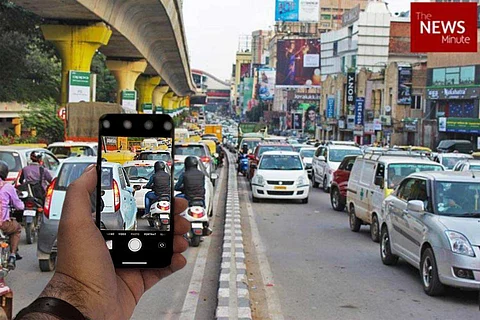

The recent trend of netizens posting pictures of traffic violators on social media might have made it easier for the police to fine offenders but has resulted in violating the privacy and safety of citizens. Pictures of violators are posted by people on social media platforms like Twitter along with details such as the location and time of the violation. Several pictures clicked by netizens show the identities of the violators, co-passengers and other passers-by, including children and women, raising privacy, safety and security concerns.
Speaking to TNM, Kuyil Mozhi, a law graduate from Chennai, says, “Since anyone can take pictures of others on the road by claiming to be reporting traffic violations, it can become a tool in the hands of perverts. Not all those taking pictures need to be doing it with noble intentions.” She adds that there is no law that considers taking pictures of others on public roads as a violation.
Advocate Nagasaila corroborates, “Since there is no law in place, vulnerab,le sections of society such as children can be easily targeted. In the process of nabbing violators of traffic, citizens’ short-sighted misplaced enthusiasm to expose violators might subject these vulnerable groups to other kinds of crimes.”
On July 14, a Twitter user from Chennai uploaded a photo of three women travelling without helmets on one scooter. In the image, the faces of two of the women are clearly visible and their identity card tag, which has the logo of the institution they are affiliated with, is also seen. The Twitter user tweeted the image along with other details such as the location and the time they were spotted. “Even if you argue that they are violators, it doesn’t give anyone the right to shame them publicly by posting their pictures on social media without their consent. The law assures everyone the right to live with dignity,” Nagasaila comments.
Several tweets posted by different Twitter users exposed the faces of school-going girls, minor boys and children who are either co-passengers or passers-by. In particular, a recent tweet posted on July 23 by a user sparked outrage from activists and netizens. The tweet, which has now been restricted from public viewing, attempted to point to a female pillion passenger on a bike who was travelling without a helmet. Responding to the tweet, users pointed out that another man to the left of the woman was also not wearing a helmet and that the user failed to report him. Several users alleged that the behaviour was creepy and amounted to voyeurism. Kuyil says, “It is time for the traffic police to stop encouraging this.”
Additional Commissioner (Traffic) Kapil Kumar from Chennai responds, “We don’t intend to encourage citizens to post such tweets. If we do not respond to a citizen’s tweet, it amounts to inaction on our part.” He adds that the department understands privacy and security concerns that individuals have raised and that individuals who believe that their privacy, dignity or security have been compromised in such pictures can lodge a complaint with the (law and order) police.
Although individuals can lodge a complaint under Tort, a civil law, through which individuals can claim damage for infringement of their rights, using the law for photos clicked on public roads is untested so far, advocate Nagasaila says. The Additional Commissioner says that vigil on social media can also be viewed as a good instrument for the traffic police as it helps in nabbing more violators and helps in involving alert citizens to enable law enforcement.
Possible way ahead
Cybersecurity expert Praveen Thalaiselvan believes that there are several ways in which the traffic police can involve the citizens and yet combat safety and privacy concerns. “One is to educate the public to blur the faces of everyone identifiable in such photos. Secondly, the police can request them to send such pictures privately to the traffic police’s Twitter DMs for which all traffic police social media handles should keep their DMs open. If not, the police should create a separate portal where netizens can file complaints to ensure that these images aren’t uploaded to social media platforms because uploading images of individuals to social media platforms without their consent is a punishable offence,” Praveen explains.
To these solutions, Vinod Arumugam, a cyber social activist, adds another layer. “The department can introduce guidelines since images which are captured by citizens can be misused. A personal privacy data policy, which will ensure that those who misuse these photos are punished under the law, can be brought in if this is to continue,” Vinod says.